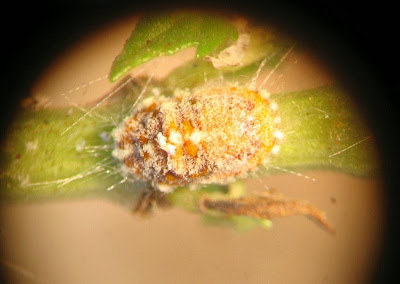Icerya purchasi, the Cottony Cushion Scale prefers Acacias (Wattles).
Scale insects belong to the large and varied order Hemiptera, which include the bugs, such as cicadas, leafhoppers, stink/shield bugs, aquatic bugs, lerps, gall insects, scale, aphids and mealybugs. However Icerya purchasi, the Cottony Cushion Scale (also known as the Australian mealybug and Fluted scale) belong to the family Margarodidae that includes the mealybugs. So what is a scale and what is a mealybug?
Well a mealybug is a scale insect as they all secrete a white waxy layer in which to live, except with mealybugs the adults have a powdery looking exterior and hence the term mealybug. Some mealybugs like the Cottony Cushion Scale also have a cottony appearance.
With the Cottony Cushion Scale, Icerya purchasi, the 5-10 mm fluted part at the rear of the insect in not the body, but masses of eggs contained within tubes that have grown from the mealybug's stomach. The actual bug is the smaller oval, colored portion with the legs.
 Cottony Cushion Scale, Icerya purchasi
Cottony Cushion Scale, Icerya purchasiDuring the early stages the young mealybugs move around seeking out suitable places to feed, ants will often carry them to various locations in order to milk them of a sweet fluid that is excreted from fine waxy tubes at their rear. At this stage they are known as crawlers or nymphs and are tiny, initially being around 0.5 mm. Once in a suitable spot, the nymph will extrude a waxy covering (the scale) and begin to feed on the sap of the host plant, which in Australia is usually an Acacia.
As I do not possess a special macro lens, I photographed this juvenile through a microscope.

The much smaller male mealybugs are rare as the female does not need them in order to produce fertile eggs, as she is a hermaphrodite, meaning that he/she/it is both male and female. The males when produced are unlike the females and develop wings in order to find the ladies, but when they emerge from a their small waxy shell they have no mouth parts and exist only to mate. Naturally their adult life span is short, but presumably a happy time.
The adult females after several moults produce their egg-sacs, usually depositing the eggs on the undersides of leaves or along small stems. As each female can produce up to a thousand eggs, this can take quite some time and they are never in a hurry.
These two ladies look like they are making good time, but you could return a day or two later and see little or no movement of either. However they can get a move on when they want to.

The photo below is not a Cushion Scale, but a more conventional scale that is mobile in its waxy (scale) covering. It was most indignant when I plucked its leaf and seemed to be saying. Oi, what do you think you're doing?

The Cottony Cushion Scale, Icerya purchasi was the subject of the first successful biological control using an introduced predator. This scale is native to Australia, but has spread to many parts of the globe where it has become a serious pest to many orchard and ornamental plants. In 1868 (after an accidental introduction) it was discovered in California, where it soon infested their citrus trees. It proved to be not only difficult to control but also very expensive and time consuming.
As there were no natural predators of the Cottony Cushion Scale in the USA, the search began in Australia where it was not a serious pest and it was discovered that the Australian Ladybird Rodolia (Novius) cardinalis fed on them. The ladybird was soon introduced to America, Europe and North Africa where the Cushion Scale was proving to be so destructive and the infestations were reduced to manageable proportions.

2 comments:
Jack, your account of these tiny creatures is absolutely fascinating.
Here is another one of those questions that probably hasn't got an answer: the male would appear to be a superfluous species as the 'female' is a hermaphrodite.
Or are they not self-fertilising? Do they need a sexual partner? I suppose if they are not self-fertilising, then the male would serve a purpose and would have better chance of seeking it's kind as it has wings.
I am also supposing that, as such numbers of eggs are produced, the survival rate is low. Do they have predetors other than lady bugs? I have never seen lady bugs in the bush, but only in gardens. Do you have lady bugs in the bush around you?
So many questions - sorry.
Regards
Gaye
Hi Gaye,
Yes the Cottony Cushion Scale can produce its own sperm and fertilise itself, however the males are produced from unfertilised eggs. The purpose of the males would probably be the need to expand the gene pool, otherwise they would become very inbred and the population ultimately weakened.
Ladybirds are the major predators of the Icerya purchasi, but some lacewings also feast on them, but generally not many animals find them appetising. I do have both ladybirds and lacewings, but not enough to make an obvious difference, but there again, I don't know the impact of continued low level predation, as overall it could be considerable.
Jack
Post a Comment